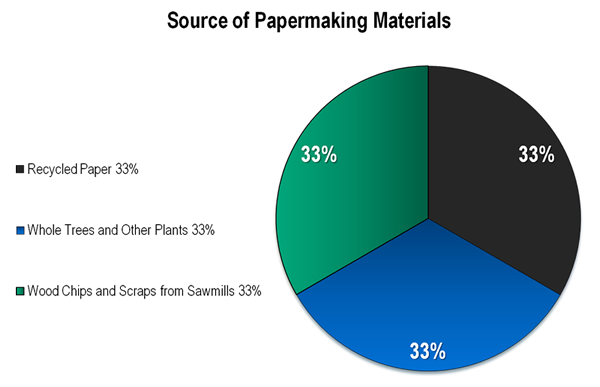Frequent Questions
You use paper and paperboard products every day, from newspapers to food packaging to office paper. In fact, paper and paperboard products make up the largest portion of the municipal solid waste stream in the United States and as a result, offer the greatest opportunity to recycle. Learn more facts and figures and other details about paper recycling in the answers to frequent questions below. You might also want to learn about the basics of paper recycling.
Paper Recycling Facts and Figures
- How much paper and paperboard is recycled every year?
- How much paper do we use in the United States each year?
- What can recovered paper be used for?
- Does all that recovered paper stay in the US?
- Where do the papermaking materials come from?
Other Frequent Questions about Paper Recycling
- How is paper recycled?
- Which states have the best access to recycling programs?
- Can a piece of paper be recycled indefinitely?
- What products can be made from recycled paper?
- Who invented paper?
- Are staples, sticky notes and other materials okay to recycle?
Facts and Figures
How much paper and paperboard is recycled every year?
- Paper accounts for about half of all recyclables collected in the US, by weight. About forty-three million tons of paper and paperboard were recovered in 2013—a recycling rate of about 63 percent. (1)
- About 67 percent of newspapers/mechanical papers and 89 percent of corrugated cardboard were recovered in 2013. Starting in 2013, newsprint and groundwood inserts expanded to include directories and other mechanical papers. (1)
- In 2013, the amount of paper recovered for recycling averaged 275 pounds for each person living in the US. (1)
How much paper do we use in the United States each year?
- About 69 million tons of paper and paperboard. (1)
- Each year, more than 2 billion books, 350 million magazines, and 24 billion newspapers are published. (3)
What can recovered paper be used for?
About 37 percent of the fiber used to make new paper products in the US came from recycled sources in 2011. (2)
Does all that recovered paper stay in the US?
In 2011, 42 percent of recovered paper was exported to overseas markets. About 53 percent stayed in the US to be recycled into paper and paperboard products. The remaining 5% was used to make other non-paper products. (2)
Where do the papermaking materials come from?
In the United States, they come from three primary sources:
- Recycled paper: 33 percent
- Whole trees and other plants: 33 percent
- Wood chips and scraps from sawmills: 33 percent

Other Frequent Questions
How is paper recycled?
Find out at the Paper University. ![]()
Which states have the best access to recycling programs?
The prevalence of available recycling program varies across the country.
Can a piece of paper be recycled indefinitely?
No, every time paper is recycled, the fibers get shorter. After being recycled five to seven times, the fibers become too short to bond into new paper. New fibers are added to replace the unusable fiber that wash out of the pulp during the recycling process. A single sheet of paper may contain new fibers as well as fibers that have already been recycled several times. (3)
What products can be made from recycled paper?
Besides easily recognizable paper products (e.g, writing paper or paper towels), more than 5,000 products can be made from recycled paper, including:
- Masking tape
- Paper money
- Globes
- Bandages
- Dust masks
- Hospital gowns
- Coffee filters
- Lamp shades
- Car insulation
- Animal bedding
- Planting pots for seedlings
- Egg cartons
Who invented paper and when?
Ts'ai Lun in 105 AD. To find out more facts about paper visit Paper University. ![]()
Are staples, sticky notes, and paper clips okay to recycle okay to recycle?
Paper mills that process recovered paper are set up to remove common contaminants such as staples and paper clips from the pulped paper. Therefore, it is not necessary to remove such items before recycling the paper, although paper clips and binder clips can be removed and reused.
If your recycling program accepts mixed paper, sticky notes are usually recyclable — but not always. Any mill that is able to process mixed paper can remove the adhesives found on sticky notes.
Sources
- (1) Advancing Sustainable Materials Management: Facts and Figures 2013
- (2) American Forest & Paper Association (AF&PA)

- (3) Technical Association of the Pulp and Paper Industry (TAPPI)

![[logo] US EPA](../gif/logo_epaseal.gif)